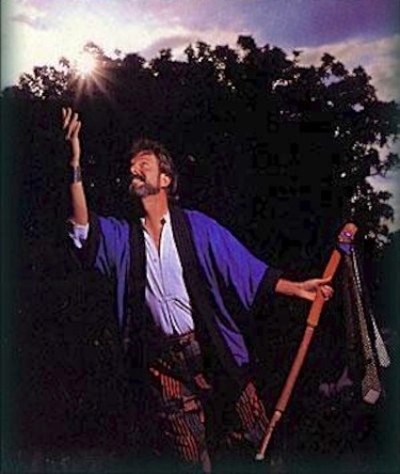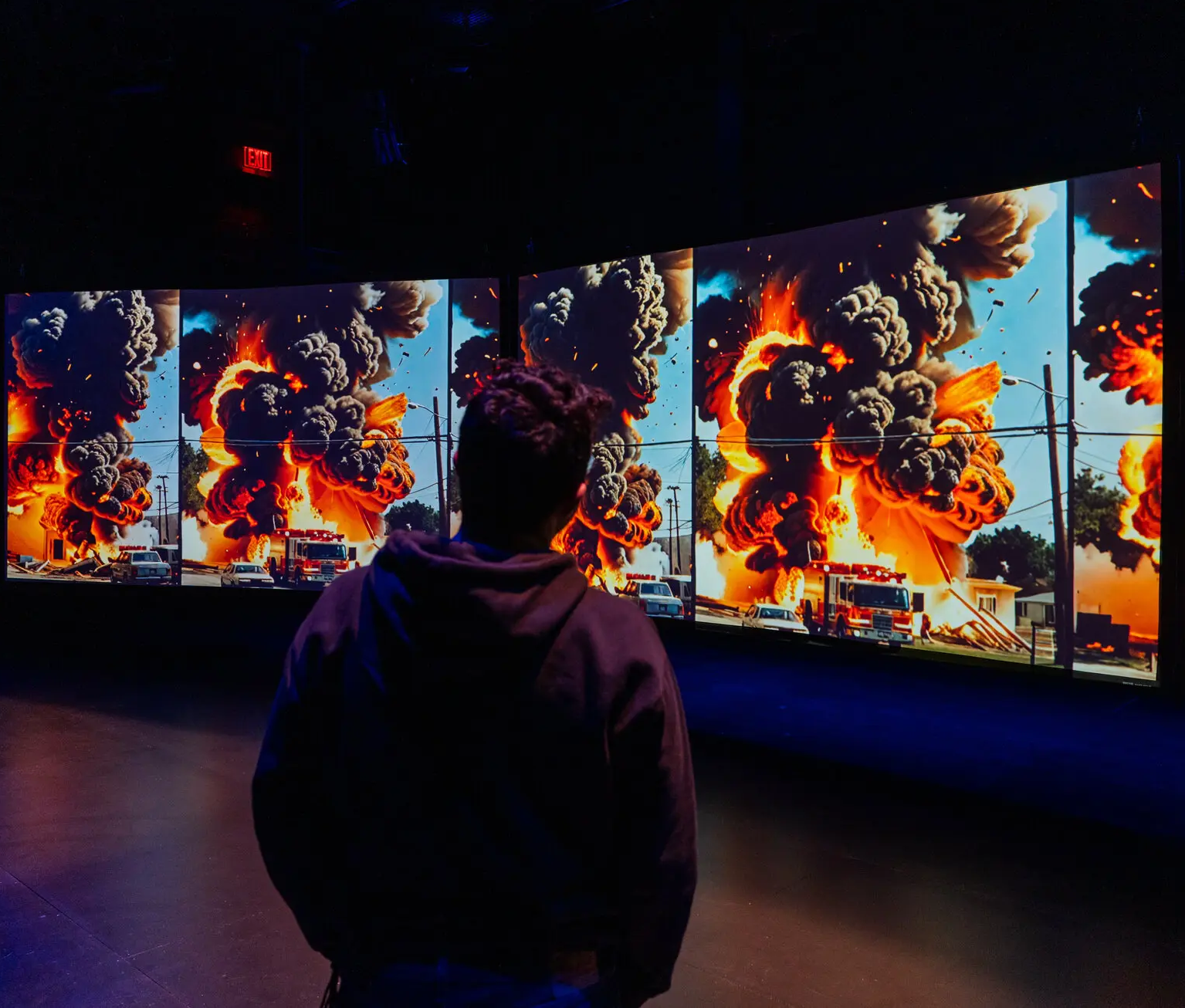ARE AMERICAN CORPORATIONS READY for the New Age? Michael Murphy, founder of the Esalen Institute, thinks so. Next year Murphy, 60, hopes to start luring business groups to Esalen, the Big Sur spa where the human-potential movement was born nearly three decades ago. Laurance Rockefeller has given $250,000 to convert the Big House, the clifftop Victorian built by Murphy’s grandparents, into a corporate retreat. George Leonard, an Esalen trustee, will offer a set of exercises based on aikido, the Japanese martial art that seeks harmony rather than dominance. Conferees will be able to select from a menu of other Esalen techniques promising everything from stress reduction to creativity enhancement.

Willis Harman warns that society is headed for a deep shift, with business sure to play a key role. Photographs by Max Aguilera-Hellweg
A few years back, all this might have seemed strange. Not anymore. Now companies like AT&T, Procter & Gamble, and Du Pont are offering employees personal-growth experiences of their own, hoping to spur creativity, encourage learning, and promote “ownership” of the company’s results. A handful of visionary leaders — General Electric Chairman Jack Welch chief among them — are going beyond training seminars to a fundamental reordering of managerial priorities. Meanwhile, a small network of consultants, thinkers, and academics are working to transform business. Propelled by a belief that the world is undergoing major change, they call for a new paradigm — a whole new framework for seeing and understanding business — that will carry humankind beyond the industrial age.
The result is a curious convergence: executives seeking ways to reverse America’s fall from dominance sharing common ground with freethinkers drawn to business as the most powerful institution in a global society. “In the Sixties these people would have slit their wrists before walking into any institution of corporate America,” says Harriet Rubin, a business books editor at Doubleday. “Now corporations are seen as a sort of living laboratory for their ideas.” As for the business side — well, Rubin’s best-selling title is Leadership Is an Art, an inspirational tome by Herman Miller Chairman Max DePree that includes chapters like “Intimacy” and “Tribal Storytelling” and is packaged with the ethereal look once reserved for the poetry of Kahlil Gibran.
What next? Crystals on the assembly line? Channeling in the boardroom? Not likely. “The whole Shirley MacLaine approach makes me ill,” says Stewart Brand, creator of the Whole Earth Catalog and now a co-founder (with former Royal Dutch Shell planning chief Peter Schwartz) of the Global Business Network, an on-line ganglion of thinkers underwritten by the likes of AT&T, Volvo, Nissan, and Inland Steel.
The new paradigm might be described as New Age without the glazed eyes. The word “paradigm” comes from the Greek for “pattern,” and the new paradigm is just that: a new pattern of behavior that stems from a new way of looking at the world. The old world view — Newtonian, mechanistic, analytical — is present in everything from the Constitution, with its clockwork system of checks and balances, to the rectilinear street plans of Washington, D.C., and San Francisco, to the assembly lines devised by Henry Ford. The new paradigm takes ideas from quantum physics, cybernetics, chaos theory, cognitive science, and Eastern and Western spiritual traditions to form a world view in which everything is interconnected, in which reality is not absolute but a byproduct of human consciousness. Nobody is promising universal enlightenment next week, however. “What we’re talking about here is not a search for nirvana,” says Michael Ray, 51, holder of the BancOne chair in creativity at the Stanford business school. “It’s an attempt to deal with a very difficult time.”
So far, what has emerged is a host of management theories and practices befitting an age of global enterprise, instantaneous communication, and ecological limits. Some are familiar: hierarchical organizations being replaced by more flexible networks; workers being “empowered” to make decisions on their own; organizations developing a capacity for group learning instead of waiting for wisdom from above; national horizons giving way to global thinking. Others may still seem a little far-out: creativity and intuition joining numerical analysis as aids to decision-making; love and caring being recognized as motivators in the workplace; even the primacy of the profit motive being questioned by those who argue that the real goal of enterprise is the mental and spiritual enrichment of those who take part in it.
Individually, each of these developments is just one manifestation of progressive management thought. Together, they suggest the possibility of a fundamental shift. Applied to business, the old paradigm held that numbers are all-important, that professional managers can handle any enterprise, that control can and should be held at the top. The new paradigm puts people — customers and employees — at the center of the universe and replaces the rigid hierarchies of the industrial age with a network structure that emphasizes interconnectedness.
WHY WOULD COMPANIES WANT to embrace a new paradigm? “Because the old paradigm isn’t working,” says Ray. He argues that the decline of American business from its postwar apogee is like a scientific anomaly — a situation the old theories fail to explain. Just as a new paradigm emerges in science when old theories stop working, the new paradigm in business began to take form when the old by-the-numbers school of management started to founder during the Seventies. The surprise success of In Search of Excellence, with its explicit attack on the old model, signaled the beginnings of a new perspective.
“We’re going back to basic values. The world is crying out for these things to become more important.”
Several factors since have encouraged the trend. Perhaps the most visible is the faltering performance that has fed the vogue for Japanese management techniques and the quest for “excellence.” But the driving force is the need for speed: The spread of computers and telecommunications and the rise of global markets have rendered bureaucracies hopelessly unwieldy. At the same time, a series of wrenching changes — deregulation, corporate takeovers, the demise of the Soviet bloc — has made the extraordinary seem commonplace. The sudden backlash against the money mania of the Eighties — combined, some say, with the gradual rise to power of the Sixties generation — has put idealism back on the agenda. The result is a vague but growing sense that business has to be conducted differently.
“The current world economy clearly will not work for the planet,” warns Willis Harman, 72, head of the Institute of Noetic Sciences, a Sausalito, California, organization founded by Apollo astronaut Edgar Mitchell. “It’s going to change somehow. The question is how. Do we make it through this smoothly, or do we go through real chaos — economic depression, people starving, conflict with the Third World? When society goes through a deep shift like this, we’ve got to hold the whole thing together or a lot of human misery will result. That’s why the business sector is so important.”
THOUGH THEIR EYE IS ON THE FUTURE, experts like Harman and Ray are actually building on work that began in the Forties with the socio-tech movement in Britain and the study of group dynamics in the U.S. While the socio-tech thinkers at London’s Tavistock Institute tried to get people and technology to work together smoothly in factories and coal mines, the group-dynamics crowd centered at MIT was inventing the T-group — the T stands for sensitivity training — in a series of freewheeling experiments in leadership and decision-making at the National Training Labs in Bethel, Maine. In the Fifties, West Coast psychologists began shifting their focus to personal growth. Meanwhile, MIT’s Douglas McGregor developed his famous Theory X and Theory Y, opposing styles of management based on opposing views of human nature — that people are lazy and have to be whipped into shape, or that they’re responsible and need only to be encouraged.
The split between the West Coast and the East Coast — between those mainly interested in personal growth and those more concerned with the health of the organization — persists to this day. While the personal-growth faction yielded Esalen and the human-potential movement, MIT spawned the organizational development network — consultants and academics who advocated management with a humanistic bent.

Jim Channon says he’s a shaman at heart. To AT&T, Du Pont, Whirlpool, and others, he’s a consultant.
Until a few years ago, when guru-entrepreneurs like Werner Erhard with his Transformational Technologies won lucrative personnel-training contracts from such major corporations as TRW and Ford, the West Coast human-potential crowd was considered too far-out for the business world. Organizational development, or OD, was more influential, but it faltered during the Seventies, the victim of its own naiveté: Not only did things not always get better once everybody learned to communicate freely, they sometimes got worse.
OD flourished in the military, however, under the name organizational effectiveness. A round of post-Vietnam soul-searching culminated in the establishment of Task Force Delta, a cadre of army officers whose mission was to scan for new ideas. One of their slogans was “Be all you can be,” a human-potential message that eventually found its way into the Army’s recruitment campaign. Organizational effectiveness flamed out in the early Eighties, just as the OD network was yielding a spinoff called organizational transformation, composed of people concerned less with communication and team building than with deeper issues like myth, ritual, and spirit.
Among Task Force Delta’s livelier members was Lieutenant Colonel Jim Channon, 50, now retired from the military and working as an OT consultant to such organizations as AT&T, Du Pont, and Whirlpool. He specializes in helping managers express their vision by creating a picture that makes corporate goals tangible against a starry universe or earthscape background. But at heart he sees himself as a shaman. “Three things are missing from almost every organization I’ve been through,” he says. “A sincere desire to love each other in a brotherly way, an ability to incorporate spiritual values in their work, and an ability to do something physical together.” On all three counts he thinks modern corporations could learn from tribal cultures: “Just because those guys can’t make toasters doesn’t mean that singing together, dancing together, and telling stories around a fire isn’t a damn good thing to do.”
THIS KIND OF THINKING CAN be carried only so far: “If people stop buying your toothpaste,” says Richard Beckhard, a retired professor from MIT’s Sloan School, “you can love each other all over the place and you’re still out of the toothpaste business.” But after the excesses of the greed-is-good crowd, who knows what a little altruism could do?
“Let’s say you accept Milton Friedman’s idea that the only business of business is profit,” says Robert Adams, a former executive vice president of Xerox. “It’s really a combination of altruism and self-interest to want to do the best for your employees, and it’s only common sense to want to treat your customers well. Why we have to learn those things from the Japanese, Lord knows.”
“Rugby is a flow sport. It looks chaotic, but it requires tremendous communication, continuous adjustment, and problem-solving without a hierarchy.” American business is more like football, with every play a call from the sidelines.
In a recent speech before San Francisco’s Commonwealth Club, Levi Strauss Chairman Robert Haas, 48, sketched his idea of the corporation of the future: a global enterprise relying on employees who “are able to tap their fullest potential” and managers who act not as authority figures but as “coaches, facilitators, and role models.” Levi Strauss is striving to transform itself along those lines because it needs creative thinking and rapid response to satisfy a fashion-conscious public. “This company isn’t turning into a group of Moonies for some Platonic management good,” observes chief counsel Tom Bauch, 47. “It’s a way of promoting our own success.”
Presumably Levi Strauss won’t be turning into a bunch of Moonies at all. The point of the new paradigm is not to get people to om out in front of some guru but to encourage them to think for themselves. Ideally, this yields an organization that functions like a rugby team. “Rugby is a flow sport,” says Noel Tichy of the University of Michigan business school. “It looks chaotic, but it requires tremendous communication, continuous adjustment to an uncertain environment, and problem-solving without using a hierarchy.” American business has been conducted more like football, with every play a call from the sidelines.
ONE MAN WHO’S READY TO PLAY rugby is Jack Welch of GE. Having streamlined GE organizationally with a flurry of sales, acquisitions, and plant closings, Welch has now turned to the culture. “Productivity is the key,” says GE’s head of management development, James Baughman, a former Harvard business school professor charged with effecting much of the change. “You can only get so much more productivity out of reorganization and automation. Where you really get productivity leaps is in the minds and hearts of people.”
Tichy, who used to work for Baughman, views the changes there as simply common sense: “It’s just treating people with dignity and making them feel like part of a team. If that qualifies as a new paradigm, so be it.” But GE’s moves bear the twin hallmarks of new-paradigm thinking: the systems view — seeing everything as interconnected — and the focus on people. Welch’s goal is fast turnaround, and to get it he intends to create what he calls the “boundaryless organization” — no hierarchical boundaries vertically, no functional boundaries horizontally. For Baughman, this means radical changes at GE’s Management Development Institute in Crotonville, New York.

Michael Murphy (seated, center) with Esalen directors and Soviet officials conferring on social transformation.
Crotonville was one place where the old-paradigm approach to business — the scientific, rationalist world view — was perfected in the years after World War II. A vast team of experts (Peter Drucker among them) codified modern management practices there in an eight-volume “blue book” that served as the manual for American business. By 1981 GE had grown an elaborate, multitiered, wedding cake bureaucracy that Welch is now blasting apart. “We wrote the book on bureaucracy,” says Baughman. “Now there aren’t any books, just real people talking about real problems face to face, sweating it out and grunting through. It’s a revolution, nothing less, from control to let-’er-rip. Historians will tell us in the 21st century if we were crazy.”
Not every company has to wait so long. Pacific Bell miscalculated badly when it hired two associates of Charles Krone, a reclusive Californian who has developed an elaborate training methodology out of a melange of systems theory, socio-tech thinking, Sufi mysticism, and the writings of G.I. Gurdjieff. Krone’s work is supposed to teach people to think more precisely, but it is jargon-laden and off-putting, and when enthusiastic Pac Bell managers tried to give it to their 62,000 workers, they discovered some people didn’t want to be told how to think — especially by their employer. While attendance at the “Krone sessions” was supposedly voluntary, those who resisted were left with the impression their careers would be jeopardized. After employee allegations of mind control sparked a public investigation, which uncovered huge expenditures on the training, the program was canceled abruptly. Pac Bell has since undertaken a more mainstream total-quality program, so far avoiding controversy.
MUST CHANGE COME FROM THE TOP to be effective? Many proponents thought so, until the Pac Bell debacle. The experience of Procter & Gamble indicates that consistent attention from on high isn’t always necessary. The giant packaged goods company began testing socio-tech ideas in its manufacturing plants more than 20 years ago, moving from the hierarchical command-and-control model to a team approach with workers largely managing themselves. Company officials rarely talked about this in public: P&G’s management style was considered part of its competitive edge and was as tightly guarded as its toothpaste formulas. Managers were even careful how they discussed it internally, since corporate headquarters in Cincinnati was focused on marketing and not particularly interested in new organizational ideas. To avoid trouble one division manager, worried about disturbing his management experiment, decreed that no one from elsewhere in the company could visit a plant without going through him.
Charles Krone, 61, whose esoteric theories would later fare so badly at Pacific Bell, was an internal organization specialist in P&G’s soap division, for which he set up a liquid detergent plant in Lima, Ohio, that outperformed every other soap plant in the company. A counterpart, Herb Stokes — now a corporate consultant and cattle rancher in Abilene, Texas — led a similarly successful effort at a P&G paper products plant he organized in Albany, Georgia. But while a number of factories like these have resisted the rigid thinking and abject boss-pleasing once labeled “bureausis,” decades of running battles within P&G suggest that what’s needed is some combination of support from the top and enthusiasm in the ranks.
What’s new about the new paradigm: the focus on human consciousness—not on capital or machinery.
That’s what a former Boise Cascade senior vice president named George McCown, 55, is trying to achieve. Besides serving as chairman of the World Business Academy, a group of business people and thinkers devoted to propagating the new paradigm, he heads McCown De Leeuw, a California investment firm that specializes in doing LBOs. He and his New York City-based partner, David De Leeuw, a former vice president of Citibank, target well- positioned but underperforming businesses and restructure them to stress empowerment of employees, creativity, and openness. Last December they joined former baseball commissioner Peter Ueberroth in his purchase of troubled Hawaiian Airlines, which Chairman Tom Talbot, a Ueberroth associate, is now trying to pull out of a “plantation mentality” by involving people at every level in an overhaul of operations.
One of McCown De Leeuw’s early buyouts was Coast Gas of Watsonville, California, a propane distribution company that has tripled in size in four years to revenues of about $100 million. While borrowing fueled much of the expansion, CEO Keith Baxter has achieved much of the company’s growth by instituting new practices that range from the mundane (a budget system) to the innovative. Having taken over a notoriously rigid organization (sample rule: No more than two employees could converse at one time), he literally tore down the walls to transform it to one in which everybody understands the business and its problems.
Helping Baxter reshape the culture at Coast Gas is Michael Blondell, a Carmel, California, consultant who works with a number of McCown De Leeuw businesses. Unlike many self-styled “change agents,” whose promises of weekend transformation are worthy of weight-loss products, Blondell works with companies on a long-term basis. “I look at spirituality, at the way people live their life,” he says. “What is their motivation? Do they want things to be better? Do they want to be open and honest? But I don’t think we’re really teaching anything new. I think we’re going back to basic, fundamental values — issues of trust, respect, dignity, commitment, integrity, and accountability. The world is crying out for these things to become more important.”
IS ANYTHING REALLY NEW about the new paradigm? Well, yes and no. “I can argue both sides,” says Noel Tichy. “No one element is new, but the attention to soft issues is new to American multinationals.”
Seventeen years ago sociologist Daniel Bell wrote that for most of human history, reality was nature; then it became technology; and now, in the postindustrial age of knowledge work and information science, it’s the “web of consciousness.” That is what’s genuinely new about the new paradigm: this focus on human consciousness — not on capital or machinery, but on people. It has challenging implications. “If consciousness is important, then money and profit are no longer that important,” argues Michael Ray of Stanford. “They’re a way to keep score, but if you don’t have any vision, you’re not going to be successful in the long run. If you go for money and that’s all, when you get it, there’s nothing there.”
So what’s the alternative? Business as a spiritual pursuit? Don’t laugh. Jack Welch recently remarked that he wants people at GE to feel rewarded “in both the pocketbook and the soul.” This is the lesson of the new paradigm: If people are your greatest resource and creativity the key to success, then business results cannot be divorced from personal fulfillment. Which is why many executives may discover, as they arise from the hot tubs at Esalen, that when you eliminate the charlatans and strip away the bull, business and human potential are the same thing. ■

 October 8, 1990
October 8, 1990





